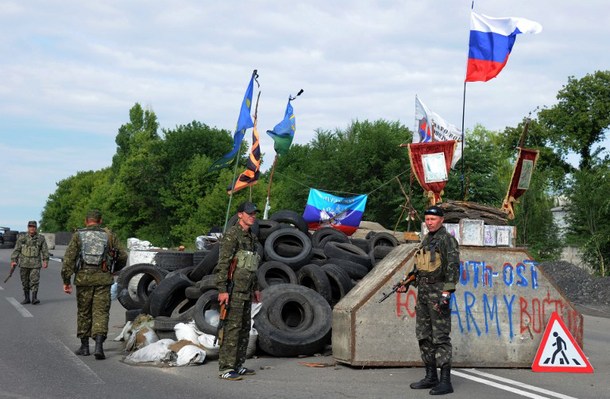
Secessionist Forces in Luhansk ‘Republic’: Order out of Chaos?
Publication: Eurasia Daily Monitor Volume: 12 Issue: 5
By:

On January 1, 2015, a military unit of the “Luhansk People’s Republic (LPR)” ambushed and killed the commander of the LPR’s rapid-reaction battalion, Lieutenant-Colonel Aleksandr Bednov (“Batman”) and six of his men. They were shelled from both sides of the road while traveling in two vehicles to the battalion’s field camp in Krasnyi Luch. Survivors of the assault blamed it on a Russian spetsnaz (special forces) unit at the disposal of the “LPR” leadership. Following the deadly ambush, Luhansk authorities arrested some of Bednov’s men, dissolved the Batman battalion and dispersed some of its personnel into other “LPR” armed units. Participants in the January 7 funeral petitioned Russia’s Investigative Committee to look into this “murder” (Informator.lg.ua, January 2–5, 2015; Novorossiya News Agency, January 7, 2015).
Bednov had defected from the Ukrainian police to “LPR” forces during the secessionist revolt in the spring of 2014. He attempted to run for “LPR president” against the incumbent, Igor Plotnitsky, in the November 2014 “elections,” but was refused registration as a candidate. Bednov’s apparent assassination has added to his hero status among some secessionist factions (Novorossiya News Agency, January 3, 2015).
Luhansk authorities have indicted several Batman battalion officers on criminal charges of abduction, extortion, unlawful detention and maltreatment of local residents. Such practices are notoriously common to secessionist forces in Ukraine’s east. Bednov himself was facing investigation on related charges. Luhansk authorities initially claimed that he died while resisting arrest, but they have not repeated that claim.
From Moscow, Colonel Igor Girkin (a.k.a. Strelkov), the foremost commander of pro-Russia forces in Ukraine’s east during 2014, characterized the Luhansk authorities’ elimination of Bednov as a “gangster-type ambush,” a “murder” and a “crime against Novorossiya.” Strelkov’s message nevertheless cautioned strongly against any retaliation or mutiny, lest it embarrass Russia and gratify Ukraine (Svodki ot Opolchenyia Novorossii, Vk.com/strelkov_info, January 2, 2015). Strelkov’s prime audience consists of those groups that criticize, as he does, the current armistice with Ukraine. Inasmuch as the “LPR” follows Moscow’s lead on this matter, those groups are out of favor in Luhansk, just as Strelkov is out of favor in Moscow.
The Batman battalion’s spetsnaz-type company, known as “Rusich” and composed of radical-right militants from Russia, seems set to defect from “LPR” forces in protest, according to company commander Aleksei Milchakov, formerly a Russian paratrooper. Field commanders “Givi” and “Motorola,” who operate semi-autonomously in the nearby “Donetsk People’s Republic” (DPR), have offered to enlist former Batman battalion personnel in their Donetsk detachments (Novorossiya News Agency, January 3, 2015; Novosti DNR, January 4, 2015).
“LPR” forces have all along lacked even the semblance of a unified command (their factionalism seems more intractable than that of “DPR” forces). Existing as they do in a lawless environment, they are also themselves involved in criminal activities. According to Girkin/Strelkov, the “LPR” is mired in “bloody chaos [krovavyi bardak]” (Novosti DNR, January 2, 2015).
Those autonomous formations are generally disgruntled over the armistice with Ukraine. And this disagreement adds a political dimension to the pre-existing and continuing organizational incoherence.
Luhansk authorities apparently plan to impose at least some discipline. The “LPR acting prosecutor-general” (identified as Zaur Ismaiylov) has warned that combatants involved in criminal activities will be prosecuted, and units refusing to join the newly created command structure (see below) would henceforth be treated as unlawful armed groups by the authorities (Luhansk Information Center, January 3, 5, 2015).
The “LPR” has recently established a Corps of People’s Militia. This seems to be intended both as a regular armed force and as an overall command structure. It is backed by Moscow and designed to subordinate or absorb the freewheeling units, so as to streamline the secessionist forces in the “LPR.” This Corps and its command headquarters, under Major-General Sergei Ignatov, emerged last December. At the same time, an “LPR” military police force and civilian police were established. A cadet school for future military officers also opened in Luhansk (Luhansk Information Center, December 23, 29, 30, 2014; Real-info/novorossiya via Interpretermag.com, January 7, 2015).
As “president [glava],” Plotnitsky is gaining in terms of military muscle. He controls the Zarya (Dawn) battalion, which is “LPR’s” oldest and strongest unit thanks to its artillery component. The new Corps of People’s Militia also falls within the sphere of Plotnitsky’ jurisdiction. This Corps has now apparently absorbed what remains of the Batman battalion (see above).
The effort to unify and institutionalize a regular “LPR” armed force is only beginning. It is facilitated in part by the respite gained through the armistice. This effort confirms the intentions to cement the secession and build a proto-state under Russia’s control in this part of Ukraine (see accompanying article).




